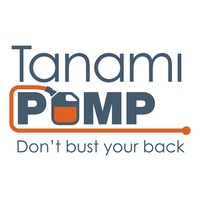Using a Tanami Pump
Author: Stoney Date Posted:15 December 2015

JERRY CAN TRANSFER LIDS
The TANAMI range of Pumps has been designed to transfer fuel, water or other liquids from metal and plastic jerry cans. It can quickly transfer fuel along a supply hose (under air pressure) to a vehicle fuel tank or reservoir without the inconvenience of moving the jerry can from its position…….Also makes a good siphon!
To operate the Tanami Pump you will require:
A 12 Volt air compressor or foot / hand pump
Earth lead / battery jumper cable
A length of 10mm / 3/8” fuel hose. Non Static (supplied)
Hose clamp (supplied)
Initial fitting may be tight!
SAFETY INSTRUCTIONS
All jerry cans used with TANAMI Pumps should be in good condition with NO dents, rust, cracked welds / seams, splits or bent spouts. The spout end face that seats with the TANAMI Pump seal must be in good condition to prevent leakage. Use of a jerry can that conforms to AS2906 is essential.
Fuel travelling a hose causes static electricity. Always make sure that your metal jerry can is earthed to your vehicle. “Use a battery jumper lead to do so”.
The Pump should always be operated in a well-ventilated area. DO NOT use inside a vehicle or enclosed space. Be wary of hot exhausts, sparks or electrical components (your compressor) in the area when operating the Pump.
Restricting / stopping the fuel flow from the fuel hose outlet can be dangerous. The hose could blow off the outlet pipe; fuel could then pour out of this pipe onto the surrounding area. The jerry can could explode from internal pressure.
A pressure relief valve (Tanami PRV) is fitted; and a small amount of air escapes from this valve constantly as it regulates the air pressure, if there is a blockage in the fuel hose the valve will open fully. Air / fuel fumes from this valve if ignited can be dangerous, and are harmful if inhaled. Under certain circumstances fuel under pressure can escape from this valve, so always have the jerry can upright when in operation. Never leave an operating TANAMI Pump unattended.
If the fuel tank or reservoir is full and fuel is then added via the fuel hose, the fuel could then overflow outside the tank or vehicle.
If the fuel hose outlet is submerged below the tank / reservoir fuel level, and the jerry can is empty, the percolation effect of air flowing through the fuel pipe can cause fuel and fumes to escape from the tank / reservoir, in the presence of a flame or heat, the fuel can ignite.
===========================================================
AIR SUPPLY for the TANAMI PUMP
The air compressor you use to supply air to the TANAMI Pumps can be very simple. The cheapest compressor available has adequate airflow and will empty a jerry can in a few minutes. High capacity 240v pumps are NOT to be used. The Tanami PRV regulates the pressure with low volume pumps (more volume / pressure from high capacity pumps will inhibit the normal operation of the Tanami PRV). The Tanami PRV relief setting (5PSI) should be checked regularly.
Note: In certain conditions after 45-60 seconds of operation, the air compressor can be switched off. The remaining volume of air will displace the remaining liquid from the jerry can.
WARNING: the jerry can and TANAMI Pumps must be kept clear (at least 4 meters) from the compressor when in operation. Any fumes or fuel spilt from the TANAMI Pumps onto the compressor motor could cause a fire.
OPERATING INSTRUCTIONS
Ensure you read the SAFETY INSTRUCTIONS before operating the TANAMI Pumps
Testing the TANAMI Pump
Find a clean empty jerry can in good condition to test your Pump set-up for leaks.
Fit your Pump to an empty jerry can and push the clamp handle down firmly. This ensures an airtight seal. (The Pump inlet pipe will sit just above the bottom far corner of the jerry can. On some jerry cans this pipe will have to be bent slightly or cut, so the lid sits securely on the jerry can neck. If the bottom of the Pump pipe touches the jerry can, the lid will not sit firmly on the jerry can neck).
Block the end of the fuel hose
Attach the airline chuck from your compressor to the inlet valve of the Pump
Wipe soapy water around the Pump lid, outlet pipe, inlet valve, pressure relief valve and all joins and welds around the jerry can
Start your compressor
Pump 5-PSI into the jerry can and check for any leaks (bubbles) appearing. The 5-PSI can be achieved by blocking the outlet hose, then turning off the compressor when 5-PSI is attained. The “Tanami PRV” opens at approximately 5-PSI.
If there are any leaks then you CANNOT use the TANAMI Pump with this jerry can
===========================================================
Operating the TANAMI PUMP
Ensure the jerry can and pump has no leaks, see “Testing the TANAMI PUMP”
Fit your Pump to a full jerry can and push the clamp handle down firmly.
If the jerry can is not earthed to your vehicle attach an earth lead.
Place the hose outlet into the fuel tank/reservoir inlet, being careful not to block the fuel flow.
Attach the airline chuck from your compressor to the inlet valve of the Pump.
Start your compressor and adjust the pressure to 5-PSI if possible. If not the Tanami PRV will regulate the pressure.
The fuel should start to flow into the tank. If your air compressor puts more then 5-PSI into the can, the Tanami PRV will open. This will regulate the pressure in the jerry can. When the jerry can is almost empty, the fuel line will start to shake from air bubbles (as air pressure overcomes fuel supply).
If you encounter a problem, pull the manual release on the Tanami PRV (this acts as an on/off valve). It releases air pressure inside the jerry can.
Turn the compressor off when you don’t see any fuel travelling along the hose. This should take approximately 1.5 – 2.5 minutes. Then pull the manual release on the Tanami PRV.
Remove the Pump, and then lift it to allow any leftover fuel to travel through the hose into the tank / reservoir.
Remove the hose from the tank and fit the end to the Pumps pipe. Coil it up and store it away in a safe place
Safety: Operating the TANAMI Pumps outside of these written parameters is unsafe and could cause accidents. An understanding of AS2906 is recommended. The supplier will in no event be liable for any direct, indirect, special, incidental or consequential damages for breach of any warranties, express or implied in fact or by law whatsoever, and it’s liability under no circumstances will exceed the purchase price of the product






